Facts About Tower Bridge: Everything You Need to Know
There’s a bridge in London so famous that people often confuse it with another. A bridge that has watched over the Thames for over a century, seen everything from royal events to daredevil stunts, and even had a bus leap across it mid-air! If this piques your interest, then you’re about to dive into the fascinating world of Tower Bridge. This article will reveal its secrets, quirks, and everything else you never knew you wanted to know.
Introduction
Tower Bridge isn’t just any bridge—it’s one of the most iconic landmarks in London. Completed in 1894, this magnificent structure spans the River Thames and connects the boroughs of Tower Hamlets and Southwark. With its twin towers and drawbridge-like design, it’s instantly recognizable and a favorite backdrop for tourists’ photos.
But Tower Bridge is more than just a pretty sight. It’s a marvel of Victorian engineering, blending functionality with architectural beauty. The bridge was built during a time when London’s trade was booming, and the city needed a way to ease traffic congestion while still allowing large ships to pass. Its design, chosen through a public competition, became a symbol of London’s industrial might and creativity.
Over the years, Tower Bridge has become much more than a practical river crossing. It has hosted countless events, witnessed historic moments, and even played a role in the 2012 Olympics. Today, it’s both a working bridge and a tourist attraction, complete with a glass walkway that offers breathtaking views of the river below.
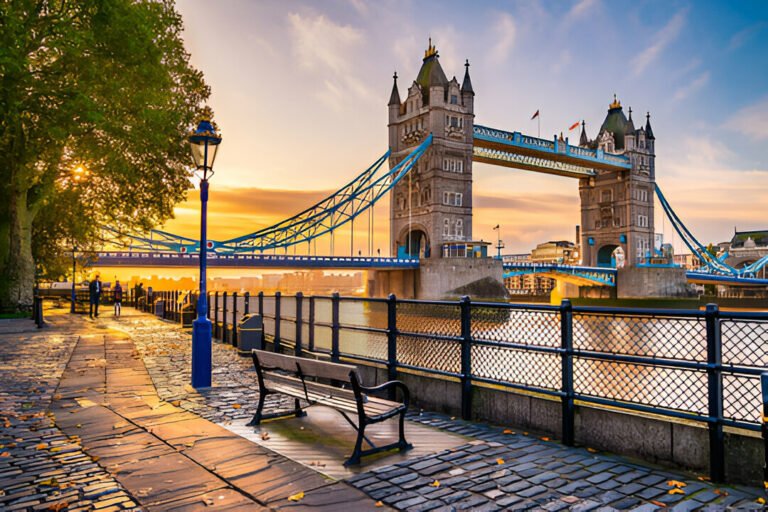
Historical Background
The story of Tower Bridge is one of vision, competition, and the determination to solve a problem that plagued Victorian London. Let’s explore the fascinating history behind this iconic structure.
When Was Tower Bridge Built?
Back in the late 19th century, London was a city bursting with energy and growth. The River Thames was the lifeline of trade and transport, but it also presented a challenge. People and goods needed to move across the river quickly, yet the existing bridges were overcrowded, and the bustling ships couldn’t be stopped.
Construction on Tower Bridge began in 1886 and was completed in 1894, taking a total of eight years. The work involved over 400 workers who labored tirelessly to build the bridge, combining steel, granite, and Portland stone to create the masterpiece we see today. It wasn’t just about functionality—it was about making something that would stand the test of time.
Why Was Tower Bridge Built?
By the late 1800s, East London was booming with trade, and the existing crossings were struggling to keep up. A new bridge was desperately needed to ease congestion and connect the growing parts of the city. However, there was a catch—it had to allow large ships to pass underneath, as the Thames was one of the busiest waterways in the world.
How the Final Design Was Chosen
The solution? A public competition that attracted over 50 designs! Some were wild, others impractical, but the winning design came from Sir Horace Jones, the City Architect, in collaboration with engineer Sir John Wolfe Barry. Their design, with its bascule (or “see-saw”) mechanism, was both elegant and efficient—a perfect blend of form and function.
Tower Bridge wasn’t just built to solve a problem; it became a symbol of innovation, creativity, and London’s unstoppable growth.
Design and Construction
Building Tower Bridge wasn’t just a simple task—it was a massive engineering challenge that required incredible skill and imagination. The bridge had to be both strong and beautiful, able to carry heavy traffic while still allowing ships to pass beneath it. The result? A masterpiece that blends practicality with stunning design.
Immense Skill and Engineering Feats
Imagine trying to build a bridge in the late 1800s, without the modern machinery we have today. Over 400 workers, including engineers, architects, and laborers, worked day and night to make Tower Bridge a reality. They used over 11,000 tons of steel to create the framework, which was then covered with granite and Portland stone to give it its iconic appearance. This wasn’t just for looks—the stone also protects the bridge from weather and wear.
The Innovative Bascule System
One of the most fascinating parts of Tower Bridge is its bascule mechanism. While many people think Tower Bridge is a drawbridge, it’s actually a bascule bridge. The word “bascule” comes from the French word for “see-saw,” and that’s exactly how it works.
The two massive sections of the bridge, called bascules, can be raised to let ships pass through. Originally, this was done using a hydraulic system powered by steam. In 1976, the system was upgraded to electricity, but the mechanism remains just as impressive today. Each bascule weighs over 1,000 tons and can be lifted in under a minute!
Two Boroughs, One Bridge
Tower Bridge connects two parts of London. On one side, you have Tower Hamlets, and on the other, Southwark. This makes it not just a functional crossing but also a link between two vibrant boroughs.
Tower Bridge is more than just a structure—it’s a testament to human ingenuity and creativity. Every detail, from its stunning towers to its clever mechanisms, tells a story of innovation and determination.
Tower Bridge Through the Years
Tower Bridge isn’t just a bridge—it’s a piece of living history. Over the decades, it has witnessed incredible moments, undergone transformations, and adapted to modern times while staying true to its original design. Let’s take a trip through its remarkable journey.
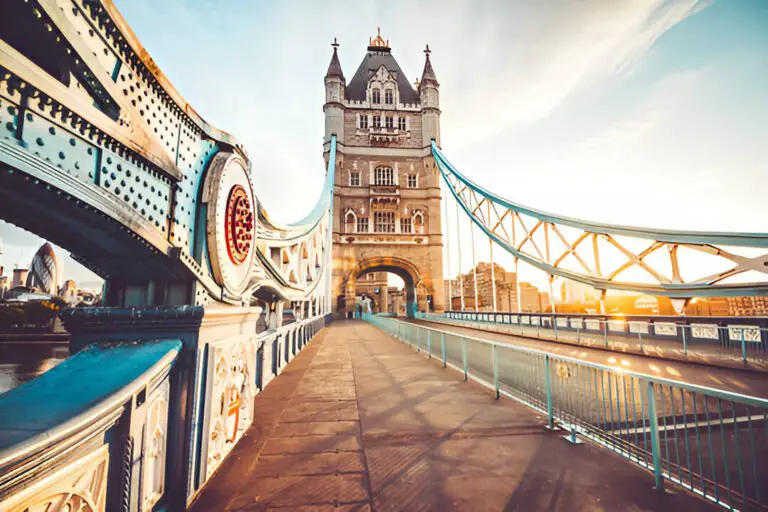
The Grand Opening Ceremony
Tower Bridge officially opened to the public on June 30, 1894, in a grand ceremony fit for a king—or rather, a prince. The bridge was inaugurated by the then Prince of Wales, who would later become King Edward VII, and his wife, Princess Alexandra. Imagine the excitement of Londoners watching as this groundbreaking bridge was unveiled for the first time! It wasn’t just a new crossing—it was a symbol of London’s progress and innovation.
Changes in Appearance
If you had seen Tower Bridge in its early days, you might not recognize it. When it was first built, the bridge was painted a rather dull brown color. This was common for Victorian structures, but let’s be honest—it wasn’t the most eye-catching look.
In 1977, everything changed. To celebrate Queen Elizabeth II’s Silver Jubilee, Tower Bridge was repainted in red, white, and blue, giving it the iconic patriotic look it still has today. This transformation added to the bridge’s charm and made it even more of a symbol of British pride.
From Steam to Electric Power
Originally, Tower Bridge was powered by a steam-driven hydraulic system, which was cutting-edge technology for the time. Huge steam engines pumped water into hydraulic accumulators, which stored the energy needed to lift the bridge’s massive bascules.
In 1976, the system was modernized and replaced with electric motors. While the steam engines are no longer in use, you can still see them in action at the Tower Bridge Exhibition, where they’re preserved as a nod to the bridge’s engineering heritage.
Unique and Fun Facts About Tower Bridge
Tower Bridge is full of surprises! Beyond its iconic appearance, this legendary structure has a fascinating history filled with quirky stories and jaw-dropping moments. Here are some of the most unique and fun facts about Tower Bridge that will leave you amazed.
Tower Bridge Is Often Mistaken for London Bridge
Let’s clear up one of the biggest misconceptions: Tower Bridge is NOT London Bridge! Tourists often mix them up, but they couldn’t be more different. London Bridge is a simpler structure further upriver, while Tower Bridge is the stunning Victorian masterpiece with its twin towers and drawbridge design. Next time you visit, make sure you get your bridges straight!
The Glass Walkway: A View Like No Other
In 2014, Tower Bridge got an exciting upgrade—a glass walkway was added to its upper level. Imagine walking 42 meters (about 138 feet) above the River Thames, with nothing but glass beneath your feet! It’s both thrilling and a little nerve-wracking, offering visitors a unique perspective of the river, the bridge, and the busy city below.
The Bus That Jumped Tower Bridge
Here’s a story straight out of an action movie: In 1952, a double-decker bus had to jump across Tower Bridge! The driver, Albert Gunton, noticed that the bascules were starting to lift while he was still on the bridge. Thinking fast, he sped up and managed to leap the gap safely. For his quick thinking, he was awarded £10—a decent sum back then!
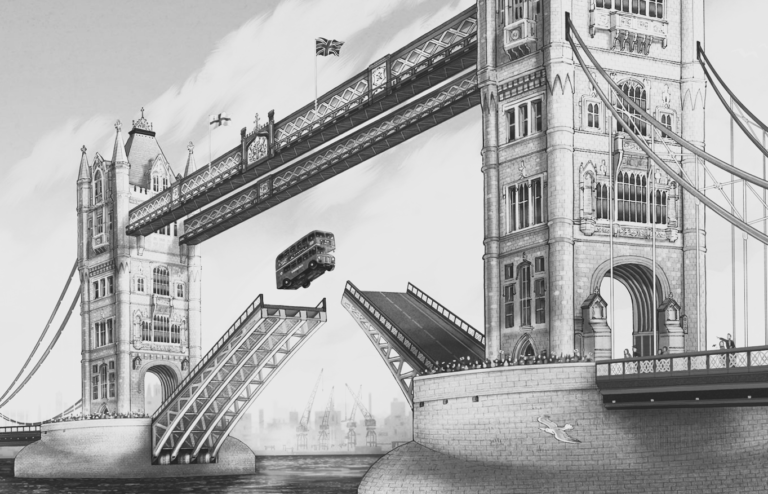
A Plane Flew Through Tower Bridge
In 1912, pilot Frank McClean pulled off an incredible (and risky) stunt. During an emergency, he flew his small biplane between the bascules and the upper walkways of Tower Bridge. It was a daring move that’s gone down in history as one of the most audacious feats associated with the bridge.
Tower Bridge and the 2012 London Olympics
Tower Bridge took center stage during the 2012 London Olympics, becoming part of the opening ceremony. Giant Olympic rings were suspended from the bridge, creating a breathtaking display that highlighted London’s role as a global city.
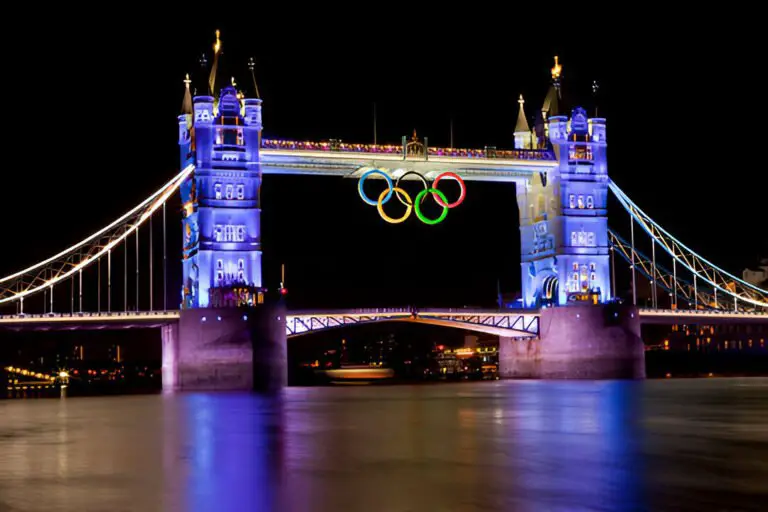
Tower Bridge in Numbers
Tower Bridge isn’t just a marvel of design and history—it’s also an impressive structure when you break it down into numbers. From its size to its daily use, these facts show just how vital and extraordinary the bridge really is.
Dimensions: A Towering Giant
Tower Bridge is no small feat of engineering. It stretches 244 meters (801 feet) in length and rises 65 meters (213 feet) high at its tallest point. The two towers are connected by high-level walkways, offering breathtaking views of London and the River Thames. Its size and scale make it not only functional but also a true architectural wonder.
Daily Usage: A Busy Crossing
Every day, Tower Bridge supports the hustle and bustle of modern London. More than 40,000 people—a mix of pedestrians, cyclists, and vehicles—cross the bridge daily. Whether it’s tourists snapping photos or locals commuting, Tower Bridge remains a vital part of the city’s infrastructure.
Bridge Lifts: Free for Vessels
One of Tower Bridge’s most fascinating features is its ability to open for river traffic. The bascules, or movable sections, are lifted about 800 times a year to allow large ships to pass through. Despite the intricate mechanics involved, it’s completely free for vessels to request a lift, provided they give 24 hours’ notice.
Why Tower Bridge Is Special
A bridge that looks like something out of a fairytale? That’s Tower Bridge in London! But this isn’t just any bridge—it’s one of the most famous in the world. Let me tell you why it’s so special.
The Architecture
Tower Bridge is like an artist’s masterpiece, combining two different styles of bridge-building. It’s both a bascule bridge (a fancy word for a bridge that can lift up to let boats pass) and a suspension bridge (a bridge that hangs on strong cables). This combination makes it unique! Imagine watching the middle of the bridge slowly split apart and rise into the air—it’s like watching a giant machine come to life. And it’s not just how it works; the bridge looks stunning too. The two massive towers on either side are designed to look like medieval castles, with pointed arches and details that make it seem like it belongs in a knight’s tale.
The History and Culture Behind It
Now, let’s talk about history. Tower Bridge is right next to the Tower of London, a place filled with stories of kings, queens, and even some ghostly legends. Being so close to such an important historical site gives Tower Bridge a sense of magic and mystery. When you see it, you’re not just looking at a bridge—you’re looking at a piece of London’s history. People all over the world recognize it as a symbol of the city.
So, Tower Bridge isn’t just a way to get across the River Thames. It’s a piece of art, a clever machine, and a link to London’s incredible past, all rolled into one. That’s what makes it so special!
Tower Bridge in Popular Culture
Tower Bridge isn’t just famous for its incredible design and history—it’s also made a big splash in pop culture. It’s one of those landmarks that people love to talk about, and it’s been part of some pretty interesting stories.
Bill Clinton’s 20-Minute Wait
Here’s a funny story: Even world leaders have to wait sometimes! Back in 1997, former U.S. President Bill Clinton was visiting London when his motorcade got stopped at Tower Bridge. Why? A large barge was passing through, and the bridge had to lift to let it through. For 20 minutes, Clinton and his team waited while the bridge did its job. Can you imagine the President of the United States just sitting there, watching the bridge rise and fall? It’s a great reminder that no one—not even a president—can rush the careful dance of Tower Bridge’s bascules.
A LEGO Masterpiece
Now, here’s something for all the LEGO fans out there! Tower Bridge has been turned into the largest LEGO structure of its kind. Using over 5.8 million pieces, builders created a life-sized model of the bridge. It’s not just a toy; it’s an incredible work of art. The model is so detailed that it even includes tiny versions of the bridge’s towers and bascules. This LEGO version of Tower Bridge shows how much people all over the world love and admire this iconic landmark.
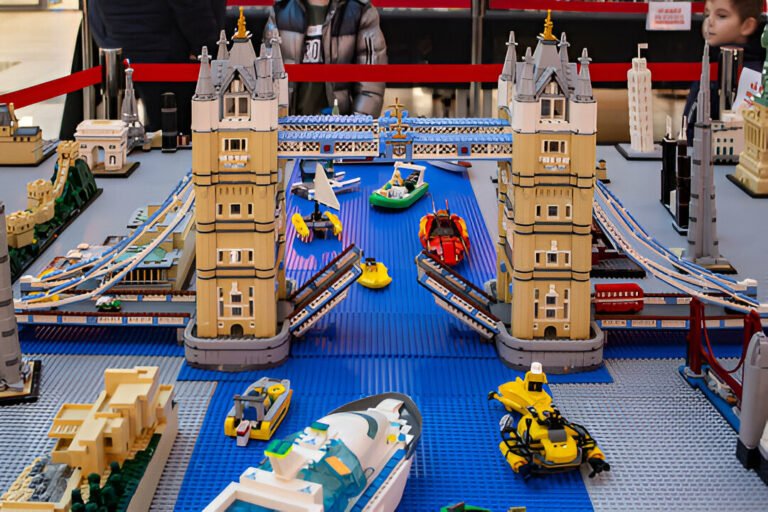
Visiting Tower Bridge Today
If you’re planning a trip to London, Tower Bridge is a must-see! But it’s not just something to look at from the outside—there’s so much to experience when you visit. Let me take you on a little tour of what makes it such a memorable place.
Walk on the Glass Floor
Tower Bridge lets you feel like you are walking in the skye. One of its coolest attractions is the Glass Floor. It’s a unique walkway where you can look straight down at the River Thames, boats passing underneath, and even the bustling city below. At first, it might feel a little scary to step out onto the glass, but trust me—it’s an unforgettable experience! Plus, it’s the perfect spot to take some amazing photos.
Explore the Tower Bridge Exhibition
Want to know how this incredible bridge works? The Tower Bridge Exhibition gives you a behind-the-scenes look at its history and engineering. You’ll learn how the bridge’s bascules (the parts that lift) work, see the Victorian-era machinery that powered it, and even hear stories about the people who built and operated it. It’s like traveling back in time to the 19th century when the bridge was first completed.
Enjoy Nearby Attractions
And the fun doesn’t stop there! Tower Bridge is surrounded by some of London’s most famous sights. Right next door is the Tower of London, where you can see the Crown Jewels and explore centuries of royal history. You can also stroll along the River Thames, enjoy stunning views of the city, and even stop by cozy cafes or souvenir shops.
Tower Bridge Resources
There are plenty of resources to help you dive into the world of Tower Bridge. From practical tips for travelers to fun educational materials for students, there’s something here for everyone.
Visitor Information and Guides
The official Tower Bridge website is your go-to source for planning a visit. It provides details on opening times, ticket prices, and current exhibitions. You can also book tickets directly through the site, ensuring a smooth experience.
Educational Materials for Schools
Educators looking to bring the story of Tower Bridge into the classroom will find a wealth of resources available. The official website offers a variety of learning materials tailored for different age groups, including activity sheets and lesson plans that delve into the bridge’s history and engineering.
Conclusion
Tower Bridge is more than just a way to cross the River Thames—it’s a symbol of London’s rich history, remarkable engineering, and cultural significance. From its unique architectural design to its role in stories that span centuries, it continues to captivate visitors and inspire people worldwide. Whether you’re walking across the Glass Floor, exploring its exhibitions, or using its resources to learn something new, Tower Bridge offers an experience that’s unforgettable. It’s a place where history and innovation come together, making it truly one of a kind.